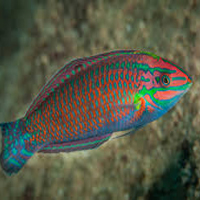Characteristics
Wrasses and napoleonfishes and cleanerfishes belong to one and the same family of Labridae. This large family holds more than 500 species. The members vary in size significantly, measuring just a few centimeters to more than 2 metres. Most species have an initial phase, consisting either entirely of females or of both females and non-sex-reversing males,
The labridae are very widespread reef fishes and they not only differ in size but also in colouring. Their brightness changes in accordance with sex and age. However, the labridae ressemble each other in their elongated body shape. Their way of swimming is quite distinctive. What they do is using their pectoral fins to propulse. They do not use their caudal fin. So, in essence, they swim by propelling themselves forward or backward with powerful strokes of their pectoral fins.
The passionately diurnal wrasse and the napoleonfish are carnivorous, feeding on small invertebrates. There are exceptions however with labridae having plankton, fish and coral on their menu. If you spot labridae during the night, you will see them sleeping half-buried in the sand or lying on one side, sheltered by rocks or a grotto and wrapped in a capsule of mucus like parrotfish do.
Species
- Bluestreak cleaner wrasse
- Broomtail wrasse
- Cheek-lined wrasse
- Clown wrasse
- Klunzinger’s wrasse
- Moon wrasse
- Napoleon wrasse
Bluestreak Cleaner Wrasse
The bluestreak cleaner wrasse is found at depths between 1 and
40 meters and measures up to 11 centimeters. It eats dead tissue of larger fishes‘ skin in a mutualistic relationship that provides food and protection for the wrasse, and considerable health benefits for the other fishes.
These wrasses are usually found in the vicinity of cleaning stations. Cleaning stations are occupied by different units of cleaner wrasses, such as a group of youths, a pair of adults, or a group of females accompanied by a dominant male. When visitors come near the cleaning stations, the cleaner wrasses greet the visitors by performing a dance-like motion in which they move their rear up and down.
Broomtail Wrasse
The broomtail wrasse is a species of wrasse, native to the Red Sea and the Indian Ocean. They can reach an average length of about 35 centimeters, with a maximum of 50 centimeters in male modus. Adults have a large head with large and bright green spots. The body is part yellow-green and part purple. This species occurs in the Red Sea to the Gulf of Oman. Broomtail wrasses can be found on coral reefs and on adjacent sand and seagrass habitats, at depths from 2 to 30 meters.
Cheek-Lined Wrasse
The cheek-lined wrasse grows to about 40 centimeters. The side of the fish’s head has horizontal stripes, while the front of the head has red spots. The coloration of this wrasse aries from pale gray to purple. They live in coral reefs, sheltered inland areas, and lagoons. This species eats sea urchins, molluscs, and crustaceans. It uses other fish as a moving blind to approach its prey.
Clown Wrasse
The clown coris or clown wrasse can grow to a staggering 120 centimeters in length. There is a significant difference in appearance between juveniles and adults. The young ones are white and orange with false eyes on the dorsal fin. The adults are uniformly dark green or with light banding, having developed a prominent forehead while maturing. The clown wrasse is happy in the vicinity of coral reefs, usually between 2 and 30 meters deep. They are generally solitary as adults.
Klunzinger’s Wrasse
The Klunzinger’s wrasse has what s called a tapering body. It measures up to 20 centimeters and swims around between 1 and 20 meters. It has a truly fascinating color scheme. The basic colour is green on the dorsal side and light blue with a red stripe along both sides. The pointed head features the same pattern.
Some female species take on another gender during their lifetime, resulting in males of the primary and secondary class. Divers will find the curious Klunzinger’s wrasse on seaward reef slopes. This wrasse craves invertebrates but it can also take on the role of a cleanerfish.
Moon Wrasse
The moon wrasse, its maximum length up to 25 centimeters, also has an amazing color scheme. Its basic colour is blue-green. The fins an the head have an amazing violet touch. The moon wrasse’s favourite hang-out are shallow lagoon waters down to a maximum of 20 meters. Its menu comprises fish eggs and small invertebrates. They hang around in mixed groups of males with harems.
Napoleon Wrasse
The napoleon or humphead wrasse is a gigantic coral reef fish, growing to even 230 centimeters. They are equipped with a very prominent bulge on the forehead and they can reach an age of 30 years old. They like to roam through coral reefs in search of hard-shelled prey such as mollusks, starfish, or crustaceans.
Juvenile napoleons are usually found in shallow sandy ranges that are bordering on coral reef waters Adults are mostly found in offshore and deeper areas of the coral reefs, more typically in outer-reef slopes. Napoleons prefer life as a single but are also found in small groups or larger combinations within their habitat. Its colour varies from blue-green to more vibrant shades of green and purplish-blue.
Other species
- Abudjubbe wrasse
- Crescent wrasse
- Chequerboard wrasse
- Eightline wrasse
- Fourline wrasse
- Indian bird wrasse
- Redbreasted wrasse
- Red Sea bird wrasse
- Red Sea thicklip wrasse
- Rockmove wrasse
- Sling-jaw wrasse
- Spotted wrasse
- Yellowbreasted wrasse
- Yellowtail wrasse



